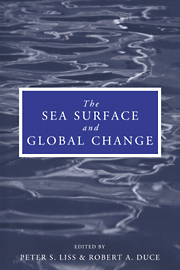Book contents
- Frontmatter
- Contents
- List of contributors
- Preface
- 1 Report Group 1 – Physical processes in the microlayer and the air–sea exchange of trace gases
- 2 Report Group 2 – Biological effects of chemical and radiative change in the sea surface
- 3 Report Group 3 – Photochemistry in the sea-surface microlayer
- 4 Transport processes in the sea-surface microlayer
- 5 The role of organic films in air–sea gas exchange
- 6 Bubbles and their role in gas exchange
- 7 The physical chemistry of air–sea gas exchange
- 8 The sea-surface microlayer and its effect on global air–sea gas transfer
- 9 Chemistry of the sea-surface microlayer
- 10 Biophysics of the surface film of aquatic ecosystems
- 11 Biological effects of chemicals in the sea-surface microlayer
- 12 Neuston of seas and oceans
- 13 Photochemistry in the sea-surface microlayer
- 14 Hydrocarbon breakdown in the sea-surface microlayer
- 15 Applications of laser technology and laser spectroscopy in studies of the ocean microlayer
- 16 Remote sensing of the sea-surface microlayer
- Index
6 - Bubbles and their role in gas exchange
Published online by Cambridge University Press: 24 September 2009
- Frontmatter
- Contents
- List of contributors
- Preface
- 1 Report Group 1 – Physical processes in the microlayer and the air–sea exchange of trace gases
- 2 Report Group 2 – Biological effects of chemical and radiative change in the sea surface
- 3 Report Group 3 – Photochemistry in the sea-surface microlayer
- 4 Transport processes in the sea-surface microlayer
- 5 The role of organic films in air–sea gas exchange
- 6 Bubbles and their role in gas exchange
- 7 The physical chemistry of air–sea gas exchange
- 8 The sea-surface microlayer and its effect on global air–sea gas transfer
- 9 Chemistry of the sea-surface microlayer
- 10 Biophysics of the surface film of aquatic ecosystems
- 11 Biological effects of chemicals in the sea-surface microlayer
- 12 Neuston of seas and oceans
- 13 Photochemistry in the sea-surface microlayer
- 14 Hydrocarbon breakdown in the sea-surface microlayer
- 15 Applications of laser technology and laser spectroscopy in studies of the ocean microlayer
- 16 Remote sensing of the sea-surface microlayer
- Index
Summary
Abstract
Bubbles can be generated at the sea surface by many mechanisms, but the main source is by the entrainment of air in breaking waves. Bubbles will scavenge material from the surrounding water, thus contributing to the cycling of dissolved and particulate organic material. When they burst at the sea surface these bubbles generate a sea salt aerosol contaminated with material scavenged from the sea-surface microlayer and below. Gases will be exchanged between a bubble and the surrounding water while it is submerged. In addition, the breaking waves and surfacing bubble plumes disrupt the surface microlayer, and this may enhance transfer of gases directly through the sea surface.
The net transfer of a gas between a bubble and the surrounding water, from entrainment until the bubble bursts or fully dissolves, contributes to the total transfer of that gas between atmosphere and ocean. This bubble-mediated transfer has some special properties that set it apart from direct air–sea transfer of poorly soluble gases. Bubble-mediated air–sea transfer velocities depend on the solubility in addition to the molecular diffusivity of the gas in seawater. Bubble-mediated transfer is not proportional to air–sea concentration difference, but is biased toward injection and the forcing of supersaturation. The entrainment of air by breaking waves increases rapidly in intensity with higher wind speeds.
- Type
- Chapter
- Information
- The Sea Surface and Global Change , pp. 173 - 206Publisher: Cambridge University PressPrint publication year: 1997
- 145
- Cited by

